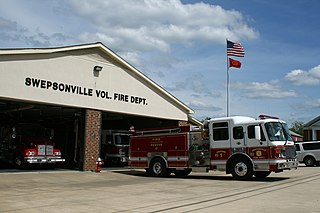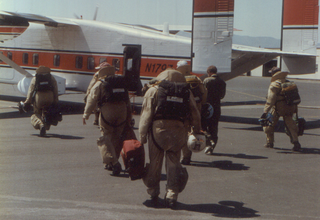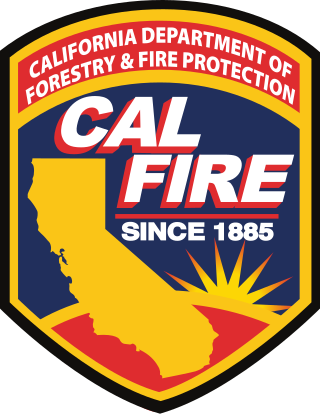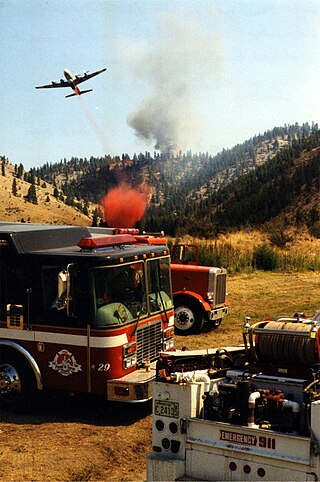
A fire engine is a road vehicle that functions as a firefighting apparatus. The primary purposes of a fire engine include transporting firefighters and water to an incident as well as carrying equipment for firefighting operations in a fire drill. Some fire engines have specialized functions, such as wildfire suppression and aircraft rescue and firefighting, and may also carry equipment for technical rescue.

A volunteer fire department (VFD) is a fire department of volunteers who perform fire suppression and other related emergency services for a local jurisdiction. Volunteer and retained (on-call) firefighters are expected to be on call to respond to emergency calls for long periods of time, and are summoned to the fire station when their services are needed. They are also expected to attend other non-emergency duties as well.

Smokejumpers are specially trained wildland firefighters who provide an initial attack response on remote wildland fires. They are inserted at the site of the fire by parachute.

For the British system, see Gold-Silver-Bronze system
Firefighting jargon includes a diverse lexicon of both common and idiosyncratic terms. One problem that exists in trying to create a list such as this is that much of the terminology used by a particular department is specifically defined in their particular standing operating procedures, such that two departments may have completely different terms for the same thing. For example, depending on whom one asks, a safety team may be referred to as a standby, a RIT or RIG or RIC, or a FAST. Furthermore, a department may change a definition within its SOP, such that one year it may be RIT, and the next RIG or RIC.
This glossary of wildfire terms is a list of definitions of terms and concepts relevant to wildfires and wildland firefighting. Except where noted, terms have largely been sourced from a 1998 Fireline Handbook transcribed for a Conflict 21 counter-terrorism studies website by the Air National Guard.

The Los Angeles County Fire Department (LACoFD) provides firefighting and emergency medical services for the unincorporated parts of Los Angeles County, California, as well as 59 cities through contracting, including the city of La Habra which is located in Orange County and is the first city outside of Los Angeles County to contract with LACoFD.
The New Zealand Fire Service was New Zealand's main firefighting body from 1 April 1976 until 1 July 2017 – at which point it was dissolved and incorporated into the new Fire and Emergency New Zealand.

The California Department of Forestry and Fire Protection is the fire department of the California Natural Resources Agency in the U.S. state of California. It is responsible for fire protection in various areas under state responsibility totaling 31 million acres, as well as the administration of the state's private and public forests. In addition, the department provides varied emergency services in 36 of the state's 58 counties via contracts with local governments. The department's current director is Joe Tyler, who was appointed March 4, 2022, by Governor of California Gavin Newsom.

The Seattle Fire Department provides fire protection and emergency medical services to the city of Seattle, Washington, United States. The department is responsible for an area of 142.5 square miles (369 km2), including 193 miles (311 km) of waterfront, with a population of 713,700. There is a total of 1,065 employees with 981 uniformed personnel and 84 civilian employees.

Wildfire suppression is a range of firefighting tactics used to suppress wildfires. Firefighting efforts in wild land areas require different techniques, equipment, and training from the more familiar structure fire fighting found in populated areas. Working in conjunction with specially designed aerial firefighting aircraft, these wildfire-trained crews suppress flames, construct fire lines, and extinguish flames and areas of heat to protect resources and natural wilderness. Wildfire suppression also addresses the issues of the wildland–urban interface, where populated areas border with wild land areas.

The National Interagency Fire Center(NIFC) in Boise, Idaho is the American physical facility which is the home to the National Interagency Coordination Center (NICC), and the National Multi-Agency Coordination group (NMAC or MAC).
According to the National Incident Management System (NIMS), the Incident Base is one of five predesignated temporary facilities and it is the location at which primary support activities are conducted for emergencies like a wildland fire. A single incident base is established to house all equipment and personnel support operations. The Logistics Section, which orders all resources and supplies, is also located at this base. The Incident Base should be designed to be able to support operations at multiple incident sites.
As firefighting has a rich history throughout the world, traditions in this profession vary widely from country to country.

Helitack crews are teams of wildland firefighters who are transported by helicopter to wildfires. Helicopters provide rapid transport, enabling helitack crews to quickly respond and assess a wildfire situation. Helitack crews may land near a wildfire or, if equipped and trained, rappel from a hovering helicopter. Once on the ground, crews build firelines using hand tools, chainsaws, and other firefighting tools. They often remain overnight in remote locations. After they have completed their assignment, crew members may pack up to 120 pounds of equipment over difficult terrain to reach a pick-up point. Rappellers often prepare helispots that provide better access to a fire. Helicopter crew members may also perform other duties such as tree falling, firing operations, and managing helibases.
The provision of rescue and firefighting services (RFFS) at all airports and aerodromes in the United Kingdom is a requirement under British law and under international agreements set out by the International Civil Aviation Organization.
Wildfire suppression equipment and personnel is part of the science of fire fighting focusing on the use of specialized equipment, training and tactics to effectively control, surround and eventually extinguish a natural cover fire. There are several specially designed tools that through their function and user training, perform specialized tasks that are specific to natural cover firefighting. This is used together in conjunction with the general understanding of the behavior of fire to form a viable plan of attack.

Firefighting in the United States dates back to the earliest European colonies in the Americas. Early firefighters were simply community members who would respond to neighborhood fires with buckets. The first dedicated volunteer fire brigade was established in 1736 in Philadelphia. These volunteer companies were often paid by insurance companies in return for protecting their clients.

On August 18, 1937, a lightning strike started the Blackwater Fire in Shoshone National Forest, approximately 35 miles (56 km) west of Cody, Wyoming, United States. Fifteen firefighters were killed by the forest fire when a dry weather front caused the winds to suddenly increase and change direction. The fire quickly spread into dense forest, creating spot fires that trapped some of the firefighters in a firestorm. Nine firefighters died during the fire and six more died shortly thereafter from severe burns and respiratory complications. Another 38 firefighters were injured. The fire killed more professional wildland firefighters in the U.S. than any other in the 103 years between the Great Fire of 1910 and the Yarnell Hill Fire in 2013.

The Vancouver Fire Department (VFD) provides fire protection and emergency medical services to the city of Vancouver and, by contract, Clark County Fire District 5, in Washington, United States. The VFD's response area is 91 square miles (240 km2) with a population of over 288,000 (2021). The VFD has the highest call volume per firefighter in the state. ALS transport is provided by AMR, making the VFD's service area population by far the largest in Western Washington without public ALS ambulance service.














